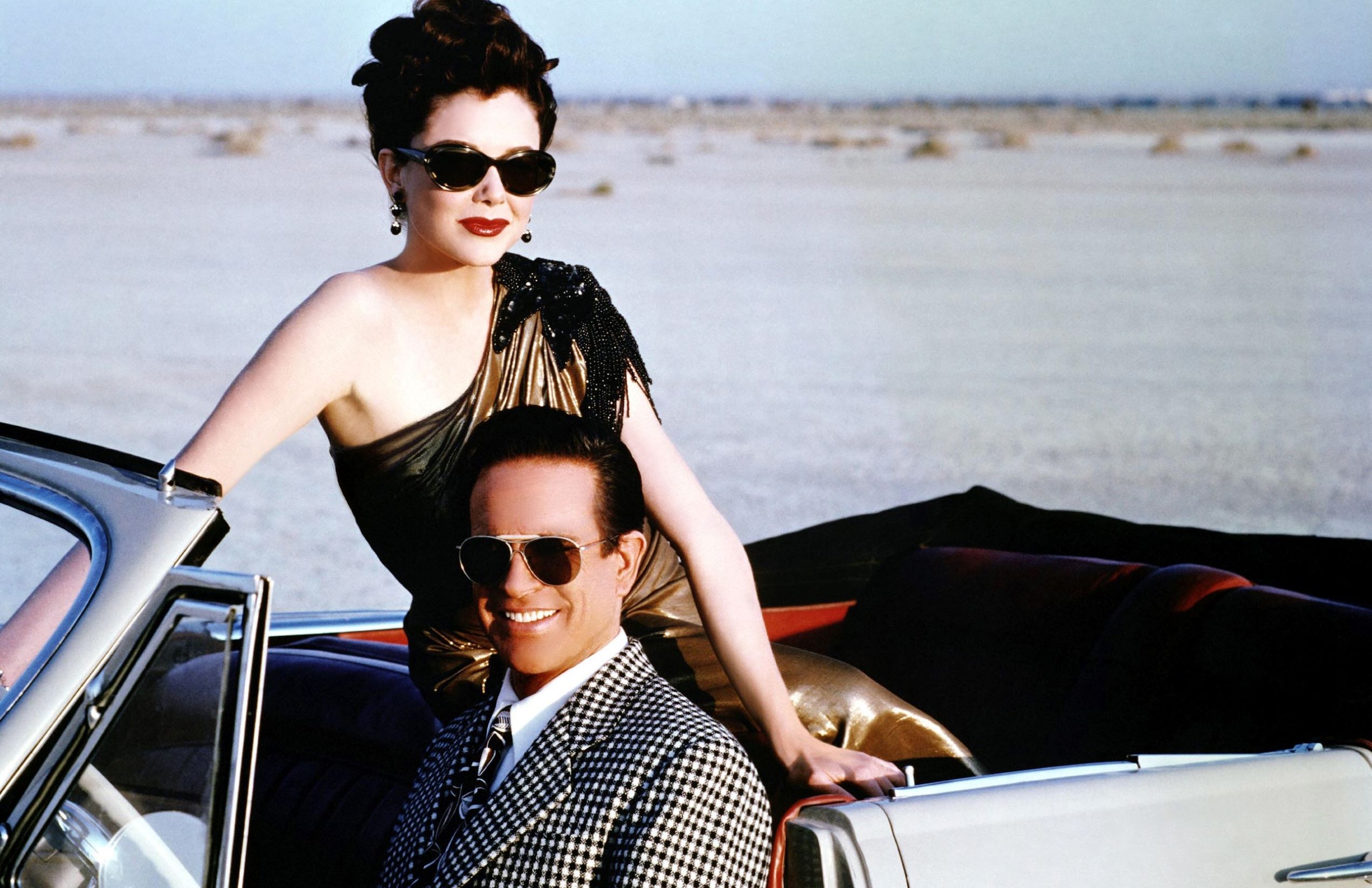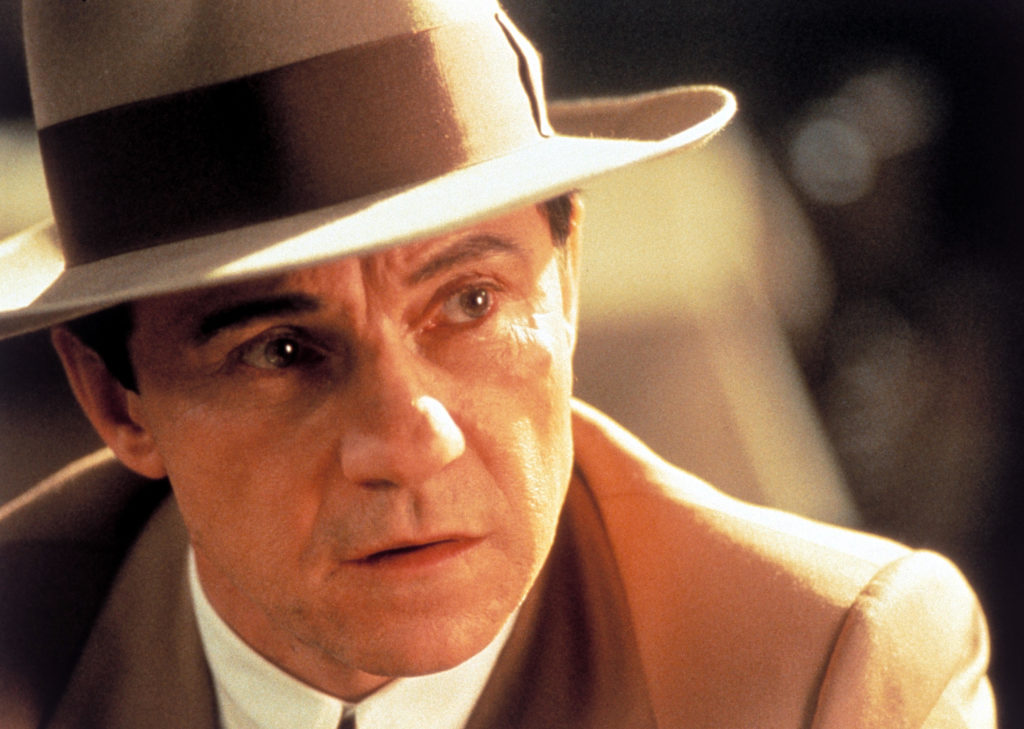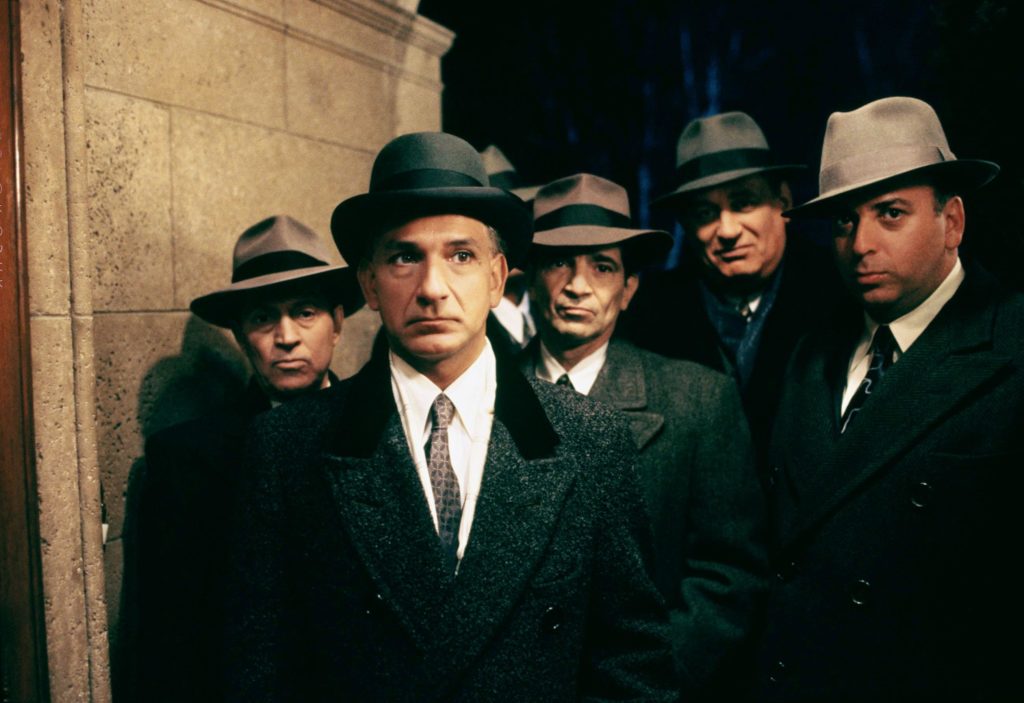
Hollywood’s ‘Bugsy’ is entertaining but plays fast and loose with the facts
Portrayal of rise and fall of mobster Benjamin “Bugsy” Siegel was released 30 years ago this month

In the 1991 movie Bugsy, Warren Beatty, portraying mobster Benjamin “Bugsy” Siegel, stands in the desert near Highway 91 south of Las Vegas. He scans the empty terrain, imagining, during an “epiphany,” its potential. In a car nearby are his girlfriend, Virginia Hill (Annette Bening), and Los Angeles mobster Mickey Cohen (Harvey Keitel).

The scene is a pivotal moment in the movie, highlighting a major event in Southern Nevada history, the apparent creative spark that led to the December 26, 1946, opening of the Flamingo Hotel. During the post-World War II years, the lavish resort would attract widespread attention.
“The Flamingo, the most respected casino of its time in America, put Vegas on the map,” writes Jeff Burbank in his 2005 book Las Vegas Babylon.
Like many movies based on true stories, however, Bugsy, directed by Barry Levinson, compresses some events to save time and invents others, such as the “epiphany” scene, for dramatic effect. The goal is to create a compelling story, not a documentary. But inevitably the guessing game — “Did that really happen?” — becomes part of the movie’s legacy.
Below are important storylines in Bugsy that are based on true events but aren’t always factual.
1. Though Siegel saw the Flamingo through to completion, as the movie depicts, the idea for it originated not with him, but with Billy Wilkerson, publisher of the Hollywood Reporter and owner of successful Los Angeles nightclubs.
A compulsive gambler, Wilkerson had been going to Las Vegas since the late 1930s, drawn to the action in legal casinos. A friend suggested that since he visited the place so often on gambling excursions, he should build a casino there, where he could gamble, but also own the house, said historian Larry Gragg, author of Benjamin “Bugsy” Siegel: The Gangster, the Flamingo, and the Making of Modern Las Vegas, published in 2015.
That suggestion inspired Wilkerson, but he didn’t want his project to fall in line with the Old West theme popular in Southern Nevada at the time. Wilkerson labeled his planned resort the Flamingo.
“He wanted to bring the element of Southern California lavish nightclubs to Las Vegas to attract that celebrity crowd he was used to, and the high-rollers,” Gragg said.
2. The movie creates an impression that nothing but tiny sawdust joints were operating during this period in Las Vegas — a “canker sore,” Hill calls one such place in the film.
By the time the Flamingo opened in late 1946, two Western-themed resorts, the El Rancho Vegas and Hotel Last Frontier, already were in business on Highway 91, now known as the Strip. Both of these early World War II-era hotel-casinos, which no longer exist, were built in open spaces along the highway, with a gaming floor, restaurants and other tourist amenities. But the Flamingo upped the ante, employing a more contemporary and costly design in attracting visitors to the desert.
“The Flamingo was going to be, if you will, this kind of Southern California or Miami, Florida, kind of nightclub,” Gragg said, “very, very different” from the El Rancho Vegas and Hotel Last Frontier.
Siegel, a New York mobster affiliated with childhood friend Meyer Lansky and other powerful underworld figures, had been in Hollywood and Las Vegas, overseeing the East Coast syndicate’s affairs, including handling the race wire, a valuable service that transmitted horse race results to local bookies from tracks across the country. Nevada was the first state to allow off-track betting, and Siegel capitalized on that.

Siegel also had been involved with other gangsters in downtown Las Vegas casinos and unsuccessfully attempted to buy the El Rancho Vegas on Highway 91. Seeing value in what the cash-strapped gambler Wilkerson was doing, Siegel pushed him aside in mid-1946. The resort’s construction would be financed with Mob money.
Michael Green, associate professor of history at UNLV, said the Flamingo, the first Mob-built resort on the highway to Los Angeles, sent a signal to the underworld that “the money is here, come and get it.”
“The gates were swung wide open,” Green said.
Several Strip resorts built after that were backed by Mob interests. Many of these, such as the Desert Inn, Sands and Dunes, have been demolished. Now, corporate-run casinos dominate the Strip, including the newest, the $4.3 billion Resorts World Las Vegas, which opened in June 2021. The Flamingo, still at the same location but with none of its original buildings, is owned by Caesars Entertainment, a publicly traded company.
3. During the movie, a rainstorm in the Las Vegas Valley dampens the Flamingo’s grand opening, keeping visitors away and leaving bored casino employees with little to do.
In reality, the Flamingo was packed when it opened the day after Christmas, Gragg said. People came from Southern California and throughout the region. Local residents also attended the opening. Siegel and Hill were there, greeting guests.
Gragg said there was rain in the valley that day, but only 0.12 of an inch, not “a terrific thunderstorm.”
Despite the impression left by the movie, the Flamingo’s opening run saw huge turnouts. According to newspaper columnist and radio commentator Walter Winchell, the Flamingo in its first three nights attracted 28,000 visitors, Gragg said. Among the celebrities were Jimmy Durante and Rose Marie.
“The local people wanted to see it,” the author said, “and celebrities that came over from Hollywood were excited to see it.”
The problems started, however, when the casino had a bad run of luck at the gaming tables, losing large amounts of money. Local residents, after they’d seen the Flamingo, began to frequent familiar nightspots again, such as the El Rancho Vegas on Highway 91 and the El Cortez on Fremont Street downtown.
Another problem was that the casino floor at the Flamingo had opened before the resort’s 100 guest rooms were ready. For some visitors, it was an inconvenience to spend an evening at the Flamingo and then drive to another hotel for the night.
“Not enough people were coming from out of town to fill up the casino,” Gragg said, “and if they did come, there were no hotel rooms yet.”
Mounting financial pressures resulted in the resort temporarily closing. It reopened in March 1947 and was beginning to turn the corner financially, but Siegel would not be around to help overcome the earlier difficulties. The 41-year-old gangster was shot to death on June 20, 1947, at Hill’s rented Beverly Hills residence, while she was out of town. Just six months earlier, Siegel and Hill had been together at the Flamingo’s grand opening, thanking visitors for being there.
4. As portrayed in the movie, Siegel flies home the night of the rained-out opening and is shot to death, apparently on orders from his syndicate benefactors.
Almost 75 years later, the circumstances surrounding Siegel’s murder, and the killer’s identity, remain a mystery. Because the investigation officially is still open, the Beverly Hills Police Department won’t release the Siegel file.
Over time, several theories have emerged regarding Siegel’s death.
Some people have speculated he was killed over control of the lucrative race wire. Others insist his underworld allies orchestrated the killing, upset by mismanagement of their money at the Flamingo and suspicious that he was skimming. One of Hill’s brothers, reportedly angry at Siegel for brutally mistreating Virginia, also has been mentioned as a suspect. According to another theory, mobster Moe Sedway, believing his volatile longtime friend had begun to target him for death, arranged for a gunman to carry out the task.
The person who shot Siegel was positioned outside the home late on the night of June 20, 1947, with a rifle, firing though a window. Seated on a sofa, Siegel was struck four times. One round blasted an eyeball out, sending it 15 feet onto the tiled dining room floor, according to authors Ed Reid and Ovid Demaris in their 1963 book The Green Felt Jungle.
Siegel was not alone in the room the night of the shooting, as the movie indicates. An associate, Allen Smiley, was sitting on the sofa near Siegel. When the gunfire started, Smiley ducked under a coffee table.
Less than half an hour after Siegel was shot, Sedway and two other mobsters, Morris Rosen and Gus Greenbaum, took control of the resort, Gragg said. This rapid turnaround indicates that Sedway, a Las Vegas fixer and partner with fellow New Yorker Siegel in the race wire, must have had some connection to the shooter, the author said. Clearly there was a phone call not long after the incident.
“Who organized it I cannot say with great confidence, although Moe Sedway was probably involved in some way,” said Gragg, who is working on a biography of Sedway.
Gragg has been unable to determine who pulled the trigger. “I still have not seen sufficient persuasive evidence for a particular killer,” he said.
Historical perspective
The movie also twists the historical record in its portrayal of some people important to the overall narrative.
In one scene, Siegel humiliates powerful Los Angeles Mob boss Jack Dragna (Richard Sarafian), forcing him to bark like a dog. Green pointed to this scene as one of the movie’s inaccuracies. “That definitely wasn’t Dragna,” Green said.
“Someone who knew Dragna told me that one time Dragna had Siegel and Mickey Cohen come to his office and, with my friend sitting in the corner, said, ‘Quit fighting, start getting along, or I’ll kill both of you,’ and they hugged,” the historian said.
Green said he struggles “with inaccuracies in films that deal with history,” but added he is also a believer in “getting people into the tent.”
Interest in a topic popularized by a movie such as Bugsy can guide the curious to books that delve more deeply into the subject matter.
“If they watch the movie and think, hmm, I want to know more, and pick up, say, Larry Gragg’s biography (of Siegel) or Sally Denton and Roger Morris’ The Money and the Power, they get a fuller picture,” Green said.
Larry Henry is a veteran print and broadcast journalist. He served as press secretary for Nevada Governor Bob Miller, and was political editor at the Las Vegas Sun and managing editor at KFSM-TV, the CBS affiliate in Northwest Arkansas. The Mob in Pop Culture blog appears monthly.
Feedback or questions? Email blog@themobmuseum.org





